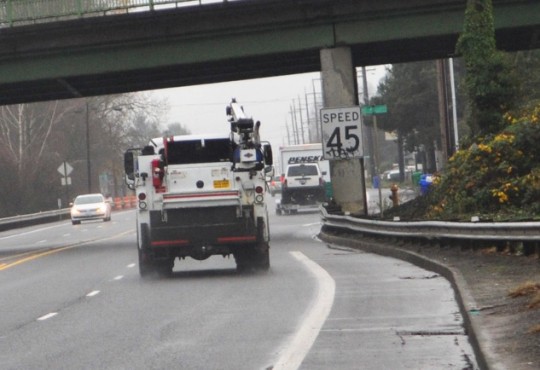
(Photo © J. Maus/BikePortland)
Maps matter. On December 12th Martin Greenough was killed while biking on a road that looks like a safe bikeway on popular bike maps. While infrastructure can take years to change, maps can be edited quickly. And that’s exactly what is starting to happen.
Metro, our elected regional government and publisher of the Bike There! map, has responded to our reporting on Martin’s death by adding a caution symbol to the bikeway gap where he was killed.
Here’s how the current printed version of the Bike There map looks (the east-west green line is Lombard Ave/Portland Hwy):
Advertisement
And here it is with edits just made in the online version of the map (note the red dots and red line on Lombard):
Locals know that this section of Lombard is an unforgiving place to ride; but Martin was new to town. He was also a fan of paper maps and his close friends have told us he used a printed bike map to find his route to and from work.
Our story last week explaining why Martin might have chosen to ride through this dangerous gap in the bike lane has brought to light a major shortcoming in the maps many people use to navigate our streets. Maps from the City of Portland and from Metro don’t do enough to differentiate between the safety of different bikeway types.
Until Metro’s actions (which only impact the online version of the map for now), none of our local maps had marked the bike lane gap where Martin died as a caution zone. This is a section of road with a severe pinch-point where people commonly drive 50 mph. I’ve stood where Martin was hit and it made me equal parts afraid and angry…
Metro has made the edit to the online version of their map. Unfortunately the printed map was just updated so it will still be a few years until these changes are reflected.
In an email, Metro’s Craig Beebe said the changes came after the agency realized the “challenging issues of the mismatch between maps, people’s perception, reality on the ground and, of course, the patterns of travel that people have to take every day to get where they’re going.”
Here’s more from Beebe:
“… Your reporting on the city of Portland’s bike map led us to take a look at how that stretch of Lombard was designated on Metro’s Bike There map. We saw that we had marked the entire stretch as having bike lanes. In Metro’s more experience/comfort-based taxonomy we marked this as ‘suitable for experienced riders.’
As a result of this crash, and your reporting, our lead cartographer for Bike There, Matthew Hampton, updated the online version of the Bike There map to mark the bike lane gap and to add a dashed-red line to the entire stretch of Lombard, denoting ‘ride with caution.'”
We haven’t heard yet whether the City of Portland plans to make edits to their maps as well.
— Jonathan Maus, (503) 706-8804 – jonathan@bikeportland.org


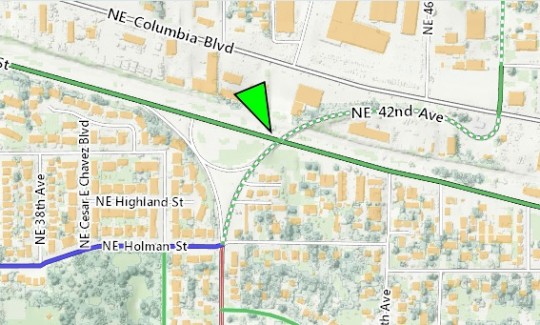
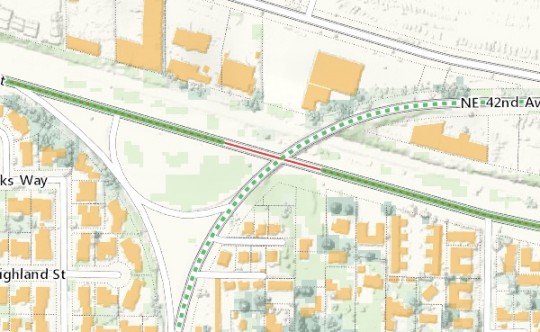
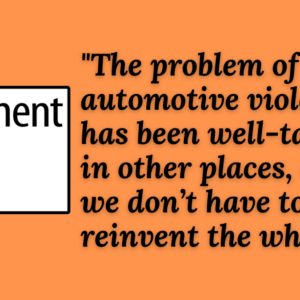
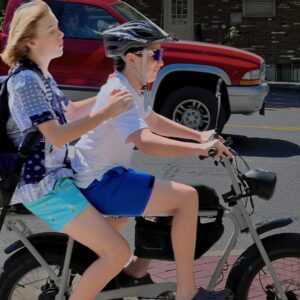
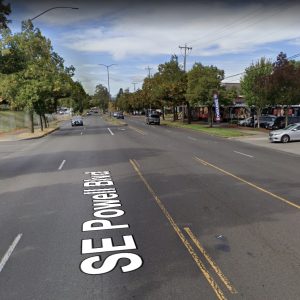
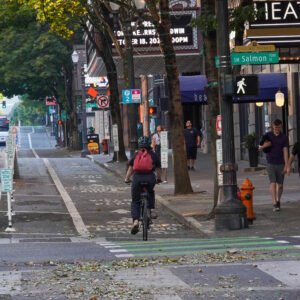
Thanks for reading.
BikePortland has served this community with independent community journalism since 2005. We rely on subscriptions from readers like you to survive. Your financial support is vital in keeping this valuable resource alive and well.
Please subscribe today to strengthen and expand our work.
Good for them! I just poked around on the map and I have other recommendations:
1. Skidmore between Michigan and NE 7th should be a ‘Bike with Caution’ or “Helpful Connection’ at best
2. Interstate at N Larrabee overpass should become ‘Bike with Caution’
3. The St Johns bridege should definitely be ‘Bike with Caution’
4. THe spot where N INterstate (southbound) becomes NE Lloyd (at NE Oregon) the bike lane drops for a a quarter mile or so; this is very sketchy and should be labeled ‘Bike with Caution’
5. 6th Ave from NE Couch to SE Clay or beyond should be ‘Helpful Connection’
#4: You are supposed to bike on the wide south sidewalk (technically a multi use path) between Oregon and where the bike lane reappears just west of MLK.
Social Engineer,
thanks for the advice, but you are not correct. There is a sign on the uphill, just before NE Oregon, instructing bikes to merge with the adjacent lane. In addition to this, the sidewalk is often crowded with pedestrians (!) and contains bridge columsn, street trees, signs, etc rendering the effective width too narrow to be considered a MUP
ITT: 14 feet is too narrow to be a MUP. Hope you never take the Springwater then. Way more pedestrian traffic there than there ever is on the NE LLoyd undercrossing.
What do you think people are supposed to when they come off the Steel Bridge and head east? They are directed onto the sidewalk. If you want to hug the curb or take the lane in that section, be my guest.
Have you ever ridden a bike down this so-called MUP? IT is 14′ in places, but that is not particularly useful when bridge columns , street signs and trees with low branch interrupt that 14′ and narrow it down to 6′-8′. I have ridden on the springwater and esplanade plenty of times, and I ride slowly and carefully to respect the people walking. This section of street is considered a bike route based on the map and the street signage, also, this section of street drops the bike lane in a way that is very sudden and surprising to people biking and people driving. I think it would be responsible to alter the map to highlight this dangerous condition. Do you disagree with that? Feel free to stop telling me where to ride, BTW.
I wouldn’t call this a MUP, either, but I ride this route daily and don’t have any problems with it until east of I-5, where the sidewalk is wildly unlevel due to street tree roots adjacent to the Convention Center parking lot. I rarely see pedestrians, just the occasional cyclist or camper under the overpass. FWIW, someone, either a cyclist or a pedestrian, was killed midday in the street at the intersection of NE Lloyd and NE 1st earlier this year.
I wouldn’t call this a MUP, either, but I ride this route daily and don’t have any problems with it until east of I-5, where the sidewalk is wildly unlevel due to street tree roots adjacent to the Convention Center parking lot. I rarely see pedestrians, just the occasional cyclist or camper under the overpass. FWIW, someone, either a cyclist or a pedestrian, was killed midday in the street at the intersection of NE Lloyd and NE 1st earlier this year.
Also, right at the NE Oregon intersection there is a green bicycle wayfinding sign directing you to “SE Portland (on sidewalk)”. Check it out next time you commute to work.
I am trying to point out a dangerous lane drop to people in the bike community, you are telling me to get on the sidewalk. I do not find your comments helpful and I do not appreciate them. The City has a sign telling people to get on the sidewalk right after it has a sign instructing bikes and cars to merge. This is why I think the map should label this section as an area requiring extra caution. I ride this route 5 days/week. I have tried the sidewalk: Bikes are flying out from the esplanade, campers and trash accumulate under the bridge, there are occasionally large groups of peds who have a hard time hearing bells/calls over the freeway noise, bikes occasionally ride northbound here which can be dangerous because of the pinch points caused by bridge columns, trees, etc, riding northbound on a a rainy night is fraught because oncoming car headlights are blinding- in short, I do not think you know what you are talking about and I do not understand why you want to defend this route as having a safe bike route designation on a map. This stretch sucks whether you ride on the street or the sidewalk and the map should reflect that
here’s what you’re talking about: https://goo.gl/maps/73vXka1Bvkn
note the bike on the roadway…
the city cannot expect people to stop, dismount, pick up their bike, place it on the sidewalk, remount, then continue along the sidewalk… that’s bad way-finding infrastructure…
stop trying to defend the bad route simply because there’s a sign telling you to do something stupid…
here is where the bike lane resumes: https://goo.gl/maps/rDd4YNwjQFT2
I don’t see any signs directing bikes off the sidewalk and back into the bike lane…
the bike lane then disappears without warning: https://goo.gl/maps/oYx8bnmfmK22
it resumes on the other side of the turn lane as a new lane (no transition)…
there’s no defending this atrocity…
Makes you wonder why people continue to ask for bike lanes when such a high percentage of them end so abruptly.
Dunno, I have been on MUP’s that are down to 6 feet. I just ride slower..just like cars drive slower on narrow roads. It’s no issue. Happy to have a path separated from cars.
That’s my work commute now, too, and I like that stretch of sidewalk. Now, getting * back* to the sidewalk riding down Lloyd from the Convention Center toward the Esplanade I find to be trickier.
Max, thanks for your comments. Will forward them to our Bike There team for review.
I will gladly volunteer my time to apply warning stickers to each and every map that is already printed.
Why not warning signs at every one of these places.
And not just for the automobiles but bicycle signage warning bicycle riders that a DOT acceptable hazard is ahead.
WARNING: ROAD MAINTAINED BY ODOT.
WARNING: Your state’s DOT has determined that bicycle riders are an acceptable loss to keep traffic moving faster.
“We haven’t heard yet whether the City of Portland plans to make edits to their maps as well.”
So far, their actions are saying “no.”
Checking one area I know too well, I see that East Burnside is shown to have continuous bike lanes from 69th to 102nd, when in reality the lanes disappear for one block on either side of 82nd. This section should be marked “bike with caution” IMHO.
I bike this intersection regularly, and agree this is an intersection where caution needs to be exercised. While heading west on Burnside, you go down a large hill before the intersection. The stoplights have no left-turn signal on Burnside…a bike moving fast from going down the hill is in danger of being hit by a negligent left-turner. I know this has nothing to do with the bike lanes, but this is a constantly-congested intersection in which cyclists should be careful.
Also, the bike lanes begin at 68th, not 69th 🙂
Thanks for the tip, Keviniano and Todd. I’ll notify our Bike There team.
Maybe it’s overdue for the “bike there” team to get out and actually Bike There. Ride the entirety of your map and see where the ball has been dropped rather than hoping for others to notify you while you sit at a desk.
Sorry to sound peeved, but this stuff can, and has, cost lives. Be a professional and field test your work before putting it out there and then regularly field test to make certain it is up to snuff.
What would it take for Metro or PBOT to recall their maps? Would stickers be possible on maps for sale or given away?
I wouldn’t call this a MUP, either, but I ride this route daily and don’t have any problems with it until east of I-5, where the sidewalk is wildly unlevel due to street tree roots adjacent to the Convention Center parking lot. I rarely see pedestrians, just the occasional cyclist or camper under the overpass. FWIW, someone, either a cyclist or a pedestrian, was killed midday in the street at the intersection of NE Lloyd and NE 1st earlier this year.
comment was supposed to be nested above…
Having accurate bike maps is certainly important, especially for people who are new to the Portland area. I think the issue that is larger than map inaccuracy is that there are some gaps in our bike network that are particularly dangerous. And it is even more dangerous when these gaps are between established bike routes. Instead of asking Metro or PBOT to recall their maps, I would ask them (and ODOT) to focus on building direct and continuous bike facilities in the future and prioritizing filling in dangerous gaps.
Metro and the city of Portland should remove all bikeways that are separated or controlled only by paint. This would leave only Neighborhood Greenways that have diverters, physically protected bike lanes, and multi-use paths.
It’s time to admit that painted bike lanes do not work without speed control and enforcement for drivers and physical separation.
My face is just fine with my nose on it, thanks.
I think the thousands of Portlanders who use bike lanes daily without incident might disagree.
Based on the photo/video above, it looks like they could have done a couple of things to make it A LITTLE safer:
1) Continue the white bike lane stripes -even if the bike lane got down to 12″ or less – continue the stripes so cars can see it. AND/OR
2) Put up a sign with flashing yellow lights a few hundred feet before the overpass “NO TRUCKS OR WIDE VEHICLES IN RIGHT LANE”, along with a speed reduction and continuing the white bike lane lines.
3) Could reduce the motor vehicle lanes to one lane under the overpass.
4) Would better lighting under the overpass help make bikes more visible on rainy, dark nights?
They could still do those things in short order until a permanent fix can be built.
Now someone needs to take the same sense of urgency and lower the speed limit on our high crash corridors. It might take a long time to implement infrastructure but it should take a long time to lower speeds on streets we know are dangerous by design and we have data that we should continue to expect crashing with the way we maintain them.
Some traffic engineer can correct me if I’m wrong, but I believe a history of crashes and also a higher than normal use by vulnerable users are both reasons that a speed limit can be lowered below its current level and below a streets design level. (I haven’t read the manuals for years, so I may be misremembering this detail.)
Great investigation, spot on observations, and scary, triple yikes. The long guardrail is to prevent the fixed object collision of the bridge pier. You are not moving the bridge pier (or the guardrail protecting it), and the road diet, not impossible but unlikely as seen at other locations in PDX. So, the simple solution, is the user path behind the rail, a couple curb cuts, a sign, maybe tapered flex bollards. A little gravel path and some minor slope work and ex under the bridge, spot paving schedule for the future. Not a problem for a small agency (with some safety funds to burn), maybe even a maintenance project with some contractor help. But a state transportation agency, entrenched, arrogant, turfy, clock watching, career protecting, clannish. While there are many good people in these bureaucracies with the best of intention, you might need an attorney to shame them into a solution at any particular location. So sad about Martin, a young man with his whole life ahead of him.
A pertinent feature of these maps would have “skull & crossbones” at every death location. I’m certain that people would notice all the kill spots, and then ask their elected officials WTF?
#portlandfailscyclists
I noticed the bike map on the outside of Whole Foods at 15th & Fremont will need an update for the Lombard gap. How many way finding maps are posted inside and outside of various stores around town, and is it safe to assume they are all lifted directly from PBOT’s maps?
I took another look at the Whole Foods wall bike map I mentioned, and it has a standard liability statement to the tune of.. they aren’t responsible for the information or what you do with it. And it hasn’t been updated since 2010.